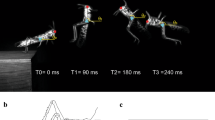Summary
1.An apparatus utilizing strain gauges was developed to measure the horizontal and vertical components of the impulse in the leap of Galago senegalensis from a platform to an equally high stage. From these components the instantaneous impulse directions and the take-off angle can be calculated.
2.Since physical laws show that 45° would be the optimum take-off angle for maximum distance, the take-off angle indicates the effectiveness of the leap — at least as far as energy is concerned. Evaluation of the instantaneous impulse directions demonstrates the effect of the horizontal and vertical forces as a function of time.
3.Two types of leap were observed: I. From a squatting position. In these leaps the take-off angle increases with stage distance (e.g. from 32° at 60 cm to 42° at 200 cm) and the standard deviation of the angle diminishes. As calculated from the instantaneous impulses, the angle from the horizontal is small at the beginning (large horizontal component, small vertical), then increases, and for short leaps even passes through a maximum before take-off is reached (Fig. 5 and 6). II. Out of previous foreward motion. Used mainly for medium long distances (about 120 cm), this type results in a steeper take-off angle. This steep angle is achieved much sooner and stays high though not constant until take-off. Apparently the animal initiates its leap with its hind legs already somewhat extended in contrast to a leap from squatting (Fig. 5 and 8).
4.The results must be understood within the context of experiment conditions and permit only limited generalization.
Zusammenfassung
1.Es wird eine Apparatur beschrieben, mit der die horizontale und vertikale Komponente des Absprungimpulses beim schrägen zweibeinigen Sprung von Galago senegalensis weglos gemessen werden können. Aus diesen Komponenten lassen sich Endimpulsrichtung (Absprungwinkel) und momentane Impulsrichtung errechnen.
2.Die Kenntnis des Absprungwinkels gestattet zu beurteilen, inwieweit die Tiere energetisch günstig abspringen, da physikalisch ein Winkel von 45° optimal wäre. Die Auswertung momentaner Impulsrichtungen zeigt, wie horizontale und vertikale Kraft als Funktionen der Zeit einwirken.
3.Zwei verschiedene Absprungtypen konnten beobachtet werden: I. Beim Absprung aus der Hockstellung wird der Absprungwinkel mit zunehmender Sprungweite vergrößert (z.B. von 32° bei 60 cm auf 42° bei 200 cm), wobei sich seine Streuung verkleinert. Der Winkel des momentanen Impulses ist zu Beginn des Absprunges klein (stärkere Krafteinwirkung in horizontaler als in vertikaler Richtung) und wird erst in dessen Verlauf vergrößert. Diese Änderung als Funktion der Zeit hat bei verschiedenen Entfernungen einen charakteristischen Verlauf. II. Beim zweiten Absprungtyp, der hauptsächlich bei mittleren Entfernungen (z. B. 120 cm) auftritt, erfolgt der Absprung steiler als bei gleichweiten Sprüngen des ersten Typs, und der Winkel des momentanen Impulses entspricht schon bei Absprungbeginn dem endgültigen Absprungwinkel. Vermutlich wird hierbei im Gegensatz zur Hocke als Ausgangsstellung eine aufgerichtete Körperhaltung mit bereits teilweise gestreckten Hinterbeinen eingenommen.
4.Die Ergebnisse müssen im Zusammenhang mit den gebotenen Versuchsbedingungen gesehen werden (z. B. Beleuchtungsverhältnissen) und sollten vorläufig nicht verallgemeinert werden.
Similar content being viewed by others
Literatur
Fricke, H. W.: Die Dehnungsmeßstreifen und ihre Anwendung. Draht-Fachzeitschr. 18, H. 4–8 (1967).
Grand, T. I., Lorenz, R.: Functional analysis of the hip joint in Tarsius bancanus (Horsfield 1821) and Tarsius syrchita (L.). Folia primat. 9, 161–181 (1968).
Hall-Craggs, E. C. B.: The jump of the bush-baby — a photographic analysis. Med. biol. Ill. 14, 170–174 (1964).
—: An osteometric study of the hind limb of the Galagidae. J. Anat. (Lond.) 99, 119–126 (1965a).
—: An analysis of the jump of the Lesser Galago (Galago senegalensis). J. Zool. 147, 20–29 (1965b).
Kurz, H.: Dehnungsmessungen, insbesondere mit Meßstreifen. Anleitung zum Praktikum „Dehnungsmessungen“, Oskar von Miller Polytechnikum, München, Umdruck MT/4/64.
Napier, J. R., Walker, A. C.: Vertical clinging and leaping — a newly recognized category of locomotor behaviour of primates. Folia primat. 6, 204–219 (1967).
Treff, H. A.: Tiefensehschärfe und Sehschärfe beim Galago (Galago senegalensis). Z. vergl. Physiol. 54, 26–57 (1967).
Author information
Authors and Affiliations
Additional information
Mit Unterstützung der Deutschen Forschungsgemeinschaft.
Rights and permissions
About this article
Cite this article
Treff, HA. Der Absprungwinkel beim schrägen Sprung des Galago (Galago senegalensis). Z. Vergl. Physiol. 67, 120–132 (1970). https://doi.org/10.1007/BF00298123
Received:
Issue Date:
DOI: https://doi.org/10.1007/BF00298123




